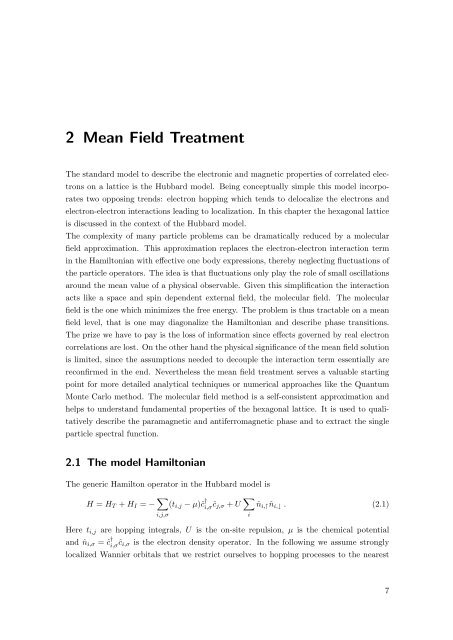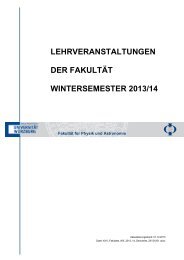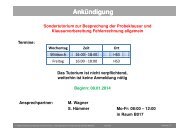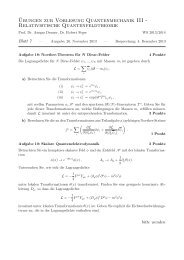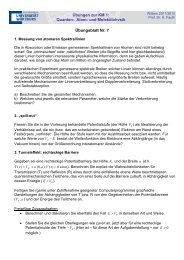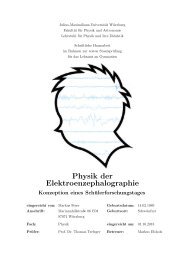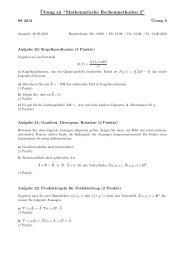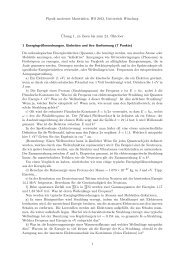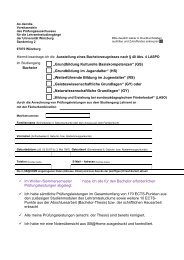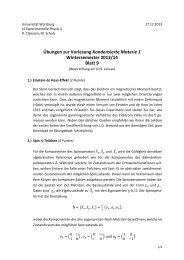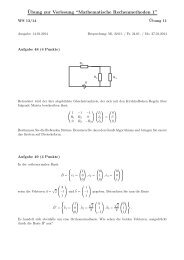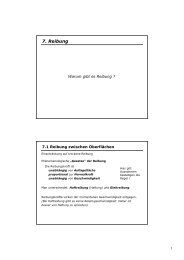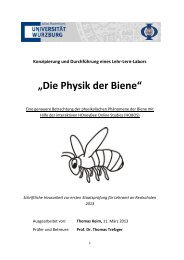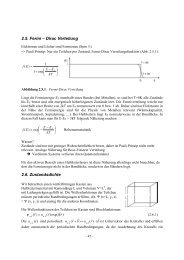Magnetic Field Induced Semimetal-to-Canted-Antiferromagnet ...
Magnetic Field Induced Semimetal-to-Canted-Antiferromagnet ...
Magnetic Field Induced Semimetal-to-Canted-Antiferromagnet ...
Create successful ePaper yourself
Turn your PDF publications into a flip-book with our unique Google optimized e-Paper software.
2 Mean <strong>Field</strong> Treatment<br />
The standard model <strong>to</strong> describe the electronic and magnetic properties of correlated elec-<br />
trons on a lattice is the Hubbard model. Being conceptually simple this model incorpo-<br />
rates two opposing trends: electron hopping which tends <strong>to</strong> delocalize the electrons and<br />
electron-electron interactions leading <strong>to</strong> localization. In this chapter the hexagonal lattice<br />
is discussed in the context of the Hubbard model.<br />
The complexity of many particle problems can be dramatically reduced by a molecular<br />
field approximation. This approximation replaces the electron-electron interaction term<br />
in the Hamil<strong>to</strong>nian with effective one body expressions, thereby neglecting fluctuations of<br />
the particle opera<strong>to</strong>rs. The idea is that fluctuations only play the role of small oscillations<br />
around the mean value of a physical observable. Given this simplification the interaction<br />
acts like a space and spin dependent external field, the molecular field. The molecular<br />
field is the one which minimizes the free energy. The problem is thus tractable on a mean<br />
field level, that is one may diagonalize the Hamil<strong>to</strong>nian and describe phase transitions.<br />
The prize we have <strong>to</strong> pay is the loss of information since effects governed by real electron<br />
correlations are lost. On the other hand the physical significance of the mean field solution<br />
is limited, since the assumptions needed <strong>to</strong> decouple the interaction term essentially are<br />
reconfirmed in the end. Nevertheless the mean field treatment serves a valuable starting<br />
point for more detailed analytical techniques or numerical approaches like the Quantum<br />
Monte Carlo method. The molecular field method is a self-consistent approximation and<br />
helps <strong>to</strong> understand fundamental properties of the hexagonal lattice. It is used <strong>to</strong> quali-<br />
tatively describe the paramagnetic and antiferromagnetic phase and <strong>to</strong> extract the single<br />
particle spectral function.<br />
2.1 The model Hamil<strong>to</strong>nian<br />
The generic Hamil<strong>to</strong>n opera<strong>to</strong>r in the Hubbard model is<br />
H = HT + HI = − �<br />
(ti,j − µ)ĉ †<br />
i,σĉj,σ + U �<br />
ˆni,↑ˆni,↓ . (2.1)<br />
i,j,σ<br />
Here ti,j are hopping integrals, U is the on-site repulsion, µ is the chemical potential<br />
and ˆni,σ = ĉ †<br />
i,σ ĉi,σ is the electron density opera<strong>to</strong>r. In the following we assume strongly<br />
localized Wannier orbitals that we restrict ourselves <strong>to</strong> hopping processes <strong>to</strong> the nearest<br />
i<br />
7


